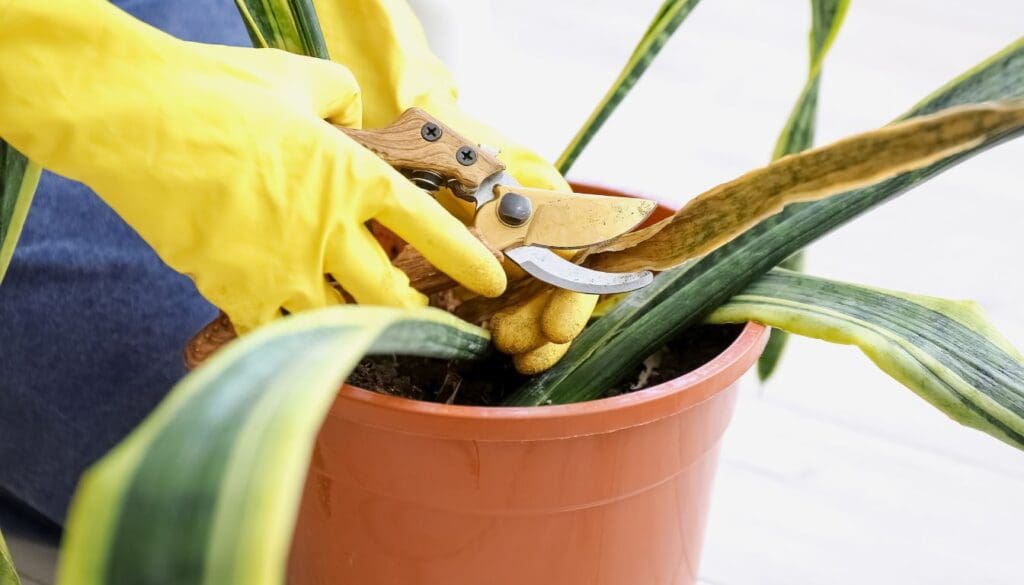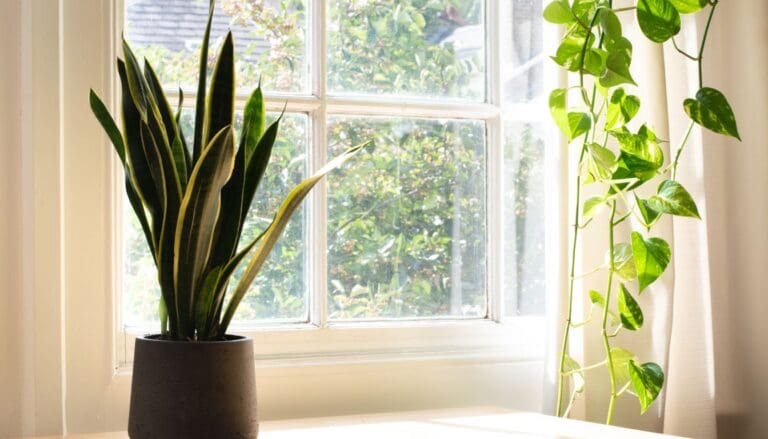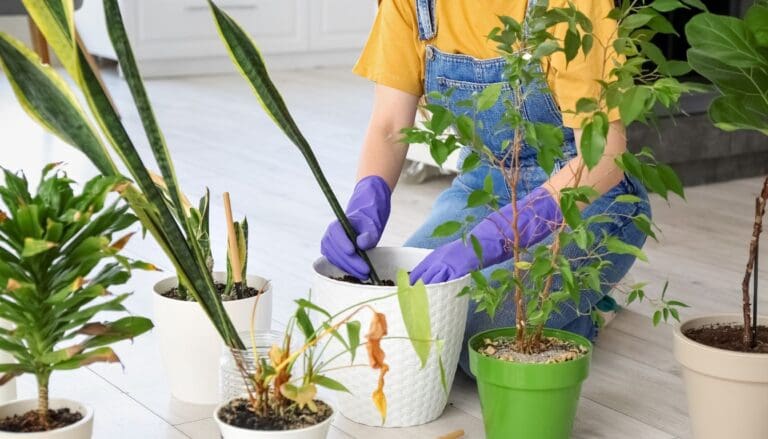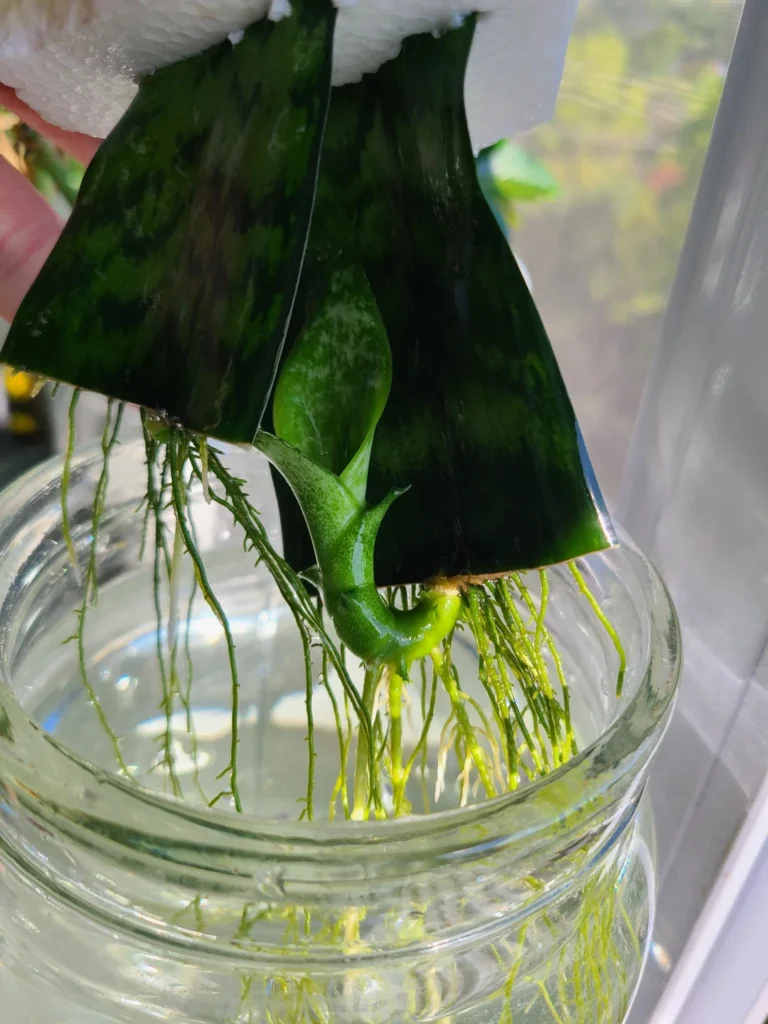How To Prune Snake Plant Leaves? (A Step-by-Step Guide)
Snake plants are one of the favorite indoor plants for plant lovers all across the globe due to their robust leaves and low-maintenance nature. However, pruning snake plant leaves is one thing many plant owners are confused about.
It would be best to prune the snake plant leaves from the base with a sharp and sterilized pruner. Try to prune as close to the soil as possible and use the cutting to grow new plants. You can pull out the damaged leaves instead of pruning them too. Avoid pruning more than 25% of the plant.
It is important to know how to prune snake plant leaves correctly. So, in this article, I will talk about the importance and process of pruning these plants correctly.

Please note: Simplify Plants is reader-supported. Some links in the post are affiliate links and I get a commission from purchases made through links in the post.
Importance of pruning snake plant leaves
Snake plants are notorious for being strong and hardy, growing very slowly but almost impossible to kill.
Being slow growers, the need to prune them is much lesser than most other plants.
In recent years, they have become a showstopper in indoor gardens with their tall upright glossy leaves that are unique and add many layers to aesthetics.
Pruning has multiple benefits for plants and thus is recommended to make them healthier and keep them in shape.
Let us now discuss why you should be pruning your snake plant periodically.
1. Control the size
Snake plants grow taller as they grow upright from the ground.
The rhizomes under the soil progressively spread, and over time, it fills the pot where it is planted.
If not pruned, the plant becomes pot-bound as the new growth of the plant fills the entire pot.
Root bound impacts its health in many ways and stunts the plant’s growth.
In such a situation, you can either keep the plant pruned to restrict its size or repot it occasionally to bigger pots.
If you find repotting a difficult and time-consuming task, you must contain the plant’s growth by pruning it in the growing period.
2. Remove damaged or diseased foliage

Removing damaged or diseased leaves are important as keeping them in the plant may spread the disease.
These leaves keep themselves attached to the plant and uselessly waste the energy which the plant otherwise can invest to produce newer and healthy leaves.
The leaves of snake plants are such that they stay for years, but any defect or damage on them also stays on, which can impact its visual beauty and make the plant look not much appealing.
To remove those leaves and improve the aesthetics of the snake plant, getting rid of those leaves is highly recommended.
3. Improve the shape
Snake plants are durable and strong, but keeping upright hard leaves in shape can be challenging after a certain time.
The older leaves often begin to droop and curl and lose their firmness, which dampens the look of the plant.
Pruning helps you eliminate those leaves and keep the plant clean and tidy.
When to prune your snake plant leaves?

To keep your snake plant in the best shape, prune them at the right time and in the right way.
Pruning should always be done in the spring or early summer when these plants grow and are the most active.
This is because during the active months’ plants find it easier to cope with the stress caused by pruning than in winter when the plant is already stressed, and pruning can lead to serious risks for the plant.
That being said, if there is any disease or fungus infection in the leaves, do not delay and immediately prune and remove those leaves.
Be careful not to remove more than one-third of the mother-in-law’s tongue at a time, and always prune the leaves at the base, not midway.
How big do snake plants grow indoors?
There are wide varieties of snake plants.
Some grow straight-up tall and thin leaves, while some grow in the shape of rosettes.
In indoor conditions, if the snake plant receives a lot of bright light, it can grow up to a foot each year.
Under such conditions, a snake plant can live up to 20-25 years.
They can reach around eight feet tall and three feet wide in optimal conditions.
However, if they are kept in low light conditions, though they will survive, their growth will be much slower.
In such cases, your plant may grow just a few inches yearly.
How much of my snake plant should I trim off?
As with any other plant, you should trim at most 25% of the snake plant at a time.
You need to leave some part of the plant intact so that it can continue its daily activities, like photosynthesis.
What you need for pruning snake plants:

Pruning is no rocket science and only requires a small list of things.
Let us discuss the equipment required below:
- Sharp pruning shears: Before beginning pruning, gets a sharp pair of pruning shears or scissors to do the process. Make sure the shears are sharp, as a blunt pair can damage the plant while pruning by making them injured. A sharp scissor keeps the cut clean, which is very important.
- Sterilize: Before beginning the process, you must sterilize the scissors because germs and pathogens spread from contaminated tools. Thus, before and after using, you need to sterilize them to clear any residues of fungus. To sterilize, you can dip a cotton ball in isopropyl alcohol, rub the blades with it, let it rest for a few minutes, and then begin using it on your plant.
- Clean surface: Pruning can be a messy and space-taking task. Thus, you need to keep the place ready before starting it. A clean bench or a counter will be fine for the purpose also, make sure you want to keep the surface clean, then cover the space with some newspapers.
- Gloves: Before beginning the pruning task, wear gloves to protect your hands, as the sap of the plant that comes out during pruning may irritate your skin and lead to infections.
How to prune snake plant leaves?

Pruning is an easy process though many plant owners are scared to conduct it, fearing they would ruin their plants.
Let us discuss how you need to begin the process:
- Examine the plant: Before starting the process, you must examine the plant very carefully. Look for the signs of damage or stress. And think about the leaves you need to get rid of to keep them in a desirable shape.
- Reduce the spread of your snake plant: Begin the process by removing the leaves around the plant’s edges or scattered in the pot. With a sharp knife or scissors, prune off the leave from as close to the soil as possible. Leaf stumps do not look good and damage the aesthetics of the plant. To cut it, hold the top of the leaf and the shear parallel to the soil and make a close cut on the leaf nearest to the soil. Keep the cut clean and not jagged, as that can increase the chances of diseases and fungal infections.
- Reduce the height: Once you have removed the extra leaves damaging the plant’s shape, focus on the height. You can cut the leaves that are taller than the rest and look lanky at the base.
- Remove damaged leaves: Once the height and width of the plant have met your expectation, now focus on the damaged leaves. Identify the leaves with sunburn, spots, infections, and yellow or brown parts ruining the cosmetic appearance of the snake plant. Do not keep your plant looking perfect, as imperfections make them real.
Experts also suggest that you should not cut down just the brown edges and tips of snake plants as it is ineffective.
The tips that you trim become brown, which increases the chances of risk and disease.
Only prune one-third of the plant.
After pruning, the plant might look sad for some days.
Remember, it is a stressful procedure for plants, so give it the necessary care and love to help it overcome the stress.
What to do with the discarded snake plant leaves?
Instead of throwing away healthy leaves, you can propagate them to get more plants.
Snake plants easily propagate in soil and water, and you can recycle healthy leaves to create more plants.
But remember to use only the healthy leaves and not the diseased ones.
You can also use the leaves in your composting bin to add to the organic elements.
However, if the leaves have any infection or fungus, it is advisable to throw them away immediately.
How often do I need to prune snake plant leaves?

As discussed above, snake plants are slow growers, and they go year after year with very little growth; thus, pruning them too frequently is not needed.
There is no specific rule as to when you should prune them, as that depends on the growing conditions and plant growth speed.
However, if you notice any parts of the plant growing in a way that damages its aesthetics, you can remove them.
It is advisable not to prune them too frequently since their growth is already slow, which would create more stress on the plant.
Before trimming your plant the next time, ensure there have been more new growths to ensure the plant does not get too bare.
Post-pruning care of snake plants

As I mentioned before, pruning causes a lot of trauma to every plant.
Your plant will show several signs of stress and sadness. However, it also stimulates the growth hormone in the plant.
You must give the ideal conditions to the plant to help it cope with the stress again.
The snake plant may look droopy for a few days after pruning, but in a few days, it should be fine.
Have patience and observe the plant to see how it is doing.
Let us discuss the ideal conditions for your snake plant to stay happy.
- Light: Snake plants are among the few that can thrive even in low-light zones. However, the best growth happens in bright indirect light. Direct scorching sunlight in summer can burn them quickly, and low light can slow the growth of these beauties.
- Temperature: The ideal temperature for them is between 59-86°F. Since they are hardy, they can tolerate temperatures slightly above and below this range, but you must protect them from extreme cold, frost, and sudden temperature fluctuation.
- Fertilizer: Feed snake plants with all-purpose liquid fertilizer or compost during the growing period, which is spring and early summer.
- Water: Snake plants’ water requirements are much less as they are succulents. The thick fleshy leaves store water in them, so they go without water for days. Make sure you let the soil completely dry in between watering.
- Soil: Snake plants are native to deserts that grow in sandy loose soil. The soil needs to have excellent drainage and not be clayey and tight. Adding sand and perlite to the soil can be ideal for these plants.
Final words

Pruning snake plants might sound a little daunting, but it is easy once you understand the right procedure. Pruning is important to keep the plant looking healthy and in shape and remove the diseased and dead leaves that unnecessarily waste the plant’s energy.
Try to prune the leaves at the base and close to the soil. Do not prune too many leaves simultaneously, as that can affect the plant’s health.
It is best to prune snake plant leaves during the day and growing season. Provide proper care to the plant after pruning to help it recover from the stress.
Source: The University of Arkansas Division of Agriculture, University of Minnesota, Snake plant profile.
Recommended Garden Supplies
| Product Image | Our Recommended Gardening Supplies | Check Offers! |
|---|---|---|
Top Top
Top
Top
Top
Top
Top
Top
Top | rePotme Houseplant and Tropical Classic Potting Soil Mix | Check Offer On Amazon |
 Top
Top
Top
Top
Top
Top
Top
Top | Espoma Organic Indoor Plant Food | Check Offer On Amazon |
 Top
Top
Top
Top
Top
Top
Top
Top | GooingTop LED Grow Light 6000K Full Spectrum Clip Plant Growing Lamp | Check Offer On Amazon |
 Top
Top
Top
Top
Top
Top
Top
Top | Soil Moisture Meter | Check Offer On Amazon |
 Top
Top
Top
Top
Top
Top
Top
Top | Govee Hygrometer Thermometer, Bluetooth Enabled! | Check Offer On Amazon |
 Top
Top | LEVOIT Humidifiers for Large Room(Best For Plants) | Check Offer On Amazon |
 Top
Top
Top
Top
Top
Top
Top
Top | Upgraded DIY Automatic Drip Irrigation Kit, 15 Potted Houseplants Support | Check Offer On Amazon |
 Top
Top
Top
Top
Top
Top
Top
Top | Stainless Steel Heavy Duty Gardening Tool Set | Check Offer On Amazon |
 Top
Top
Top
Top
Top
Top
Top
Top | Bonide Insecticidal Soap | Check Offer On Amazon |
 Top
Top
Top
Top
Top
Top
Top
Top | Bonide 32 oz Spray Neem Oil for Organic Gardening | Check Offer On Amazon |
 Top
Top
Top
Top
Top
Top
Top
Top | Garden Safe Fungicide | Check Offer On Amazon |





